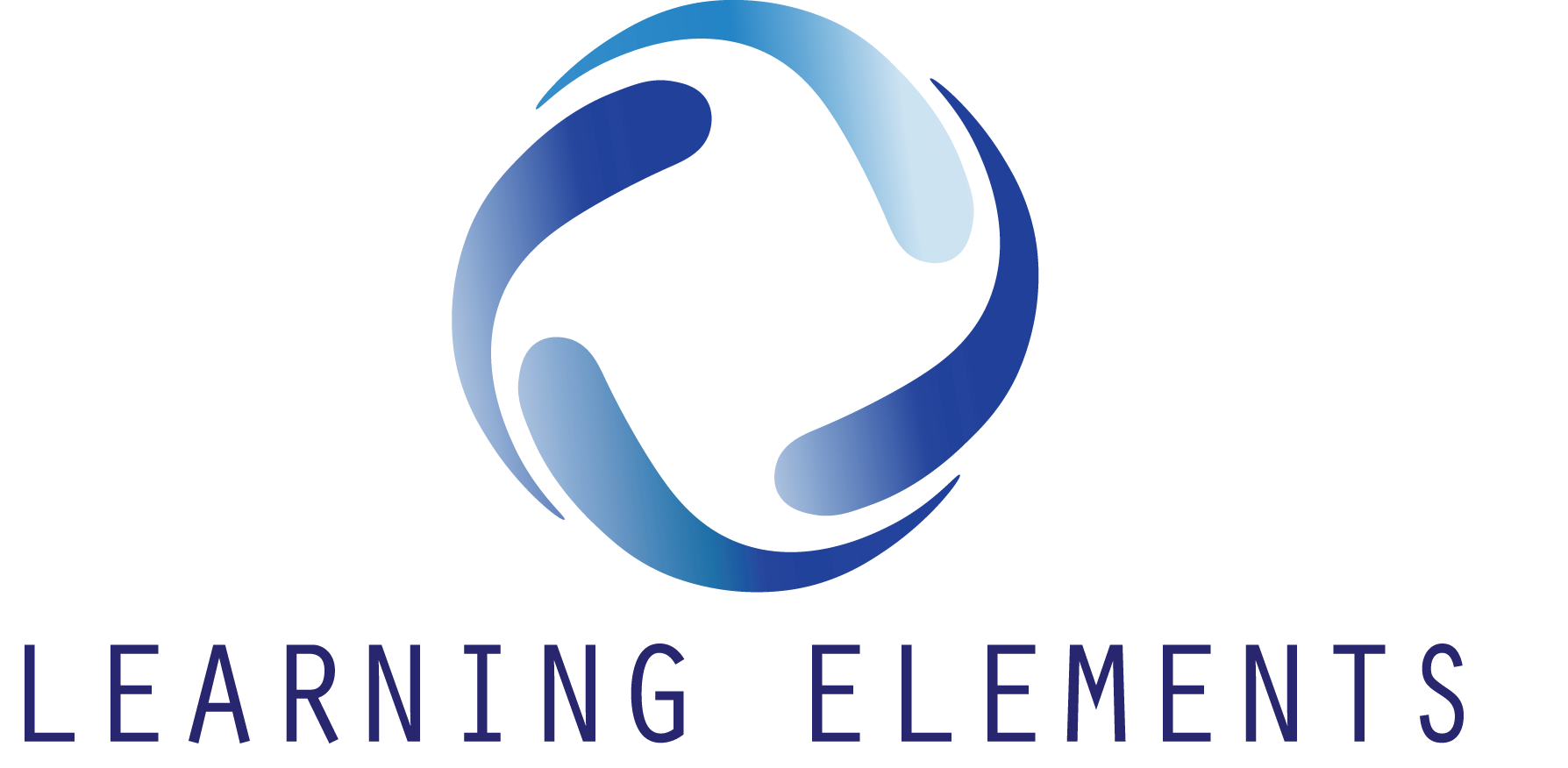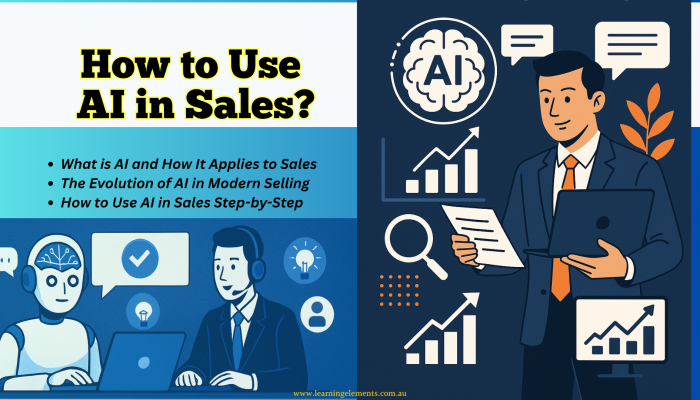How to Use AI in Sales?
AI is no longer just a buzzword in sales—it’s your new competitive advantage. From qualifying leads in seconds to personalising every touchpoint, AI empowers teams to sell smarter, not harder. This guide will walk you through how to use AI in sales, which tools deliver the greatest impact, and some proven strategies already driving faster closes and higher revenue for real-world teams. Whether you’re a sales leader, Business Development Manager (BDM), or founder, this is your roadmap to turning AI into your most valuable sales asset.
What is AI and How It Applies to Sales
Artificial Intelligence (AI) refers to computer systems capable of simulating human intelligence tasks like learning, reasoning, and problem-solving. In sales, AI tools streamline workflows, analyse large datasets, and make predictive insights possible. From identifying hot leads to customising follow‑ups, AI has become indispensable for modern sales professionals.
The Evolution of AI in Modern Selling
Gone are the days of cold calling and gut‑feel forecasting. Today’s sales cycle involves dynamic customer journeys, big data, and AI‑driven personalisation. Sales teams now rely on intelligent systems that recognise behaviour patterns, prioritise high-value prospects, and automatically suggest next‑best actions—making modern selling distinctly more strategic.
Getting Started: How to Use AI in Sales Step-by-Step
Adopting AI in sales doesn’t mean replacing your team with robots—it means augmenting their abilities with smart technology. Whether you’re leading a team or operating solo, follow these foundational steps to integrate AI meaningfully into your sales process:
Step 1: Define Your Sales Objectives
Start by identifying which parts of your sales process you want to improve. Is it lead generation? Forecasting? Personalisation? Your goals will shape your AI tool selection and success metrics.
Step 2: Audit Your Current Sales Tech Stack
Review your CRM, email systems, outreach tools, and data sources. Find gaps where AI could plug in—such as lack of intent data, poor forecasting accuracy, or low rep efficiency.
Step 3: Choose the Right AI Tools
Select AI platforms that align with your goals. For example:
- Use Gong or Chorus for conversational insights
- Drift or Exceed.ai for chatbot automation
- HubSpot CRM with AI for contact management and email tracking
Make sure they integrate seamlessly with your existing systems.
Step 4: Pilot with One or Two Use Cases
Don’t try to automate everything overnight. Start small—maybe by automating lead scoring or A/B testing subject lines—and measure results before scaling.
Step 5: Train Your Team
Even the best AI tool fails without buy-in. Educate your reps about how the tool helps them close more deals, not just monitor their performance.
Step 6: Monitor and Iterate
Use dashboards and KPIs to track AI performance. Is lead conversion improving? Are deals closing faster? Use these insights to adjust your AI strategy over time.
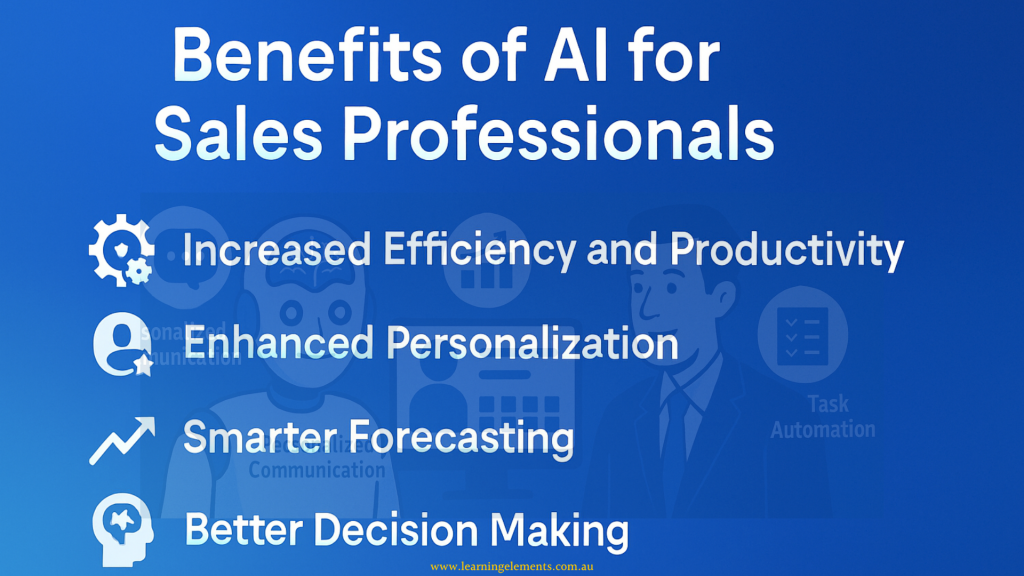
Benefits of AI for Sales Professionals
Increased Efficiency and Productivity
AI can automate routine tasks like logging CRM data, sending follow-up emails, and scheduling meetings—freeing up valuable time for sales reps to focus on building relationships and closing deals. These time-consuming admin tasks, when done manually, slow down workflows and introduce human error.
With AI, meeting scheduling becomes effortless through intelligent assistants that propose available slots, send invites, and automate reminders. It also keeps CRM records up to date by logging interactions and tracking communication history in the background. The result? Less admin, fewer missed opportunities, and more time spent selling—not inputting data.
Enhanced Personalisation
With AI, sellers can craft personalised messages at scale. By analysing buyer behaviour, demographics, and preferences, AI tailors outreach that resonates with each individual prospect. This goes beyond simply adding a first name to an email. AI tools can track website visits, content engagement, email opens, and even social media activity to determine where each buyer is in their journey. Based on these insights, it can recommend relevant case studies, suggest optimal messaging tones, and even adapt call scripts or product demos in real time.
The result is smarter, more relevant interactions that feel one-to-one—even when executed at enterprise scale. This level of personalisation builds trust faster, improves email and call engagement rates, and shortens the path to conversion.
Smarter Forecasting
AI tools can process historical sales data, market trends, and real-time signals to provide highly accurate forecasts. This reduces guesswork and improves planning. Instead of relying solely on spreadsheets or rep intuition, AI forecasting models dynamically adjust predictions as new data comes in—like changes in deal stages, buyer engagement, or macroeconomic shifts. Sales leaders gain deeper visibility into which deals are likely to close and when, while reps receive guidance on where to focus their efforts.
By identifying patterns across similar deals, AI can even alert teams to potential risks in the pipeline, such as stalled negotiations or unusually long sales cycles. Ultimately, this leads to more confident decision-making, stronger pipeline health, and better alignment between sales, finance, and leadership.
Better Decision Making
AI empowers sales professionals to make smarter, faster, and more confident decisions by turning complex data into actionable insights. Instead of relying on guesswork or outdated reports, sales teams can use AI-driven analytics to identify high-performing tactics, optimise deal strategies, and forecast outcomes with greater accuracy. Whether it’s determining which leads to pursue next, adjusting pricing strategies, or reallocating resources across the pipeline, AI ensures every decision is rooted in real-time data and predictive intelligence—minimising risk and maximising results.
AI in Lead Generation
Identifying Ideal Prospects with AI
AI analyses existing customer data to build ideal buyer personas. It then scours databases or the internet to find prospects who match those profiles. By examining firmographics, purchase behaviour, industry trends, and even customer lifetime value, AI develops a detailed picture of what your best customers look like. From there, it can automatically surface new leads from platforms like LinkedIn, company databases, and third-party data providers—saving reps hours of manual research.
These AI-driven prospecting tools not only increase lead volume but significantly improve lead quality. Sales teams can spend more time engaging with the right people and less time guessing who to contact, which directly boosts conversion rates and overall efficiency.
Predictive Lead Scoring
Machine learning models can rank leads based on their likelihood to convert. This enables reps to prioritise high-value opportunities without manual guesswork. These models learn from historical sales data—analysing attributes like job title, company size, engagement frequency, and deal outcomes—to identify patterns that signal buying intent. As new leads enter the funnel, AI compares them to past wins and losses, then assigns a predictive score in real time.
This allows sales teams to focus on leads with the highest revenue potential while automating follow-up or nurturing for lower-priority prospects. Over time, predictive scoring also improves the alignment between marketing and sales by ensuring both teams are focused on leads that actually convert.
Reducing Lead Qualification Time
AI bots or chat interfaces can quickly qualify leads by asking key questions and routing them to the right rep—dramatically shortening the sales cycle. These AI systems operate 24/7, engaging website visitors or responding to inbound queries in real time. They gather essential details such as budget, company size, purchase timeline, and pain points—allowing your team to instantly know whether a lead is a good fit.
Instead of waiting hours or days for manual follow-up, qualified leads are handed off immediately to a sales rep, complete with a conversation summary and recommended next steps. This not only improves speed to response but also reduces drop-offs during the early stages of the buying journey.
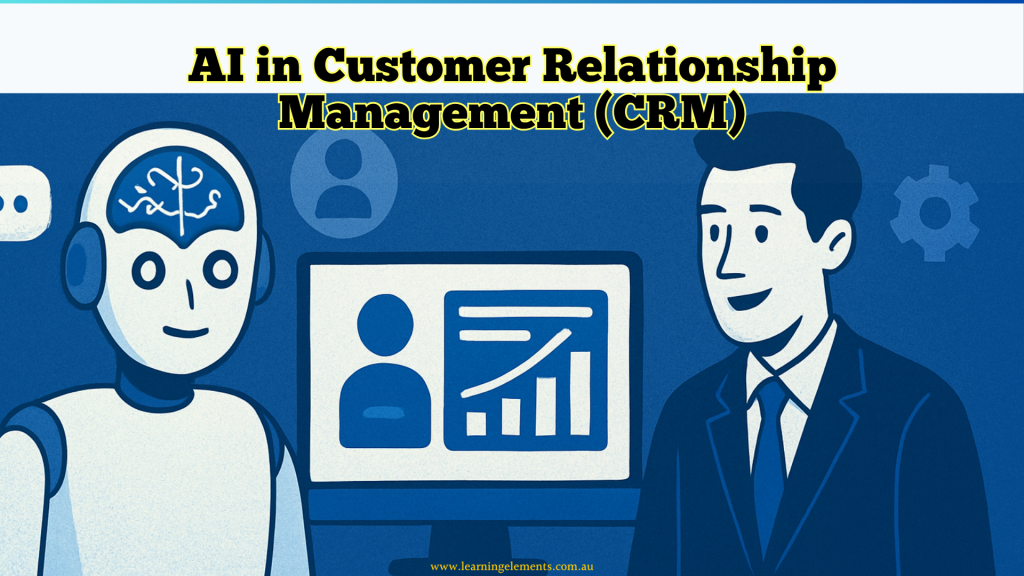
AI in Customer Relationship Management (CRM)
CRM Automation
AI can automatically log calls, transcribe meetings, update contact records, and summarise interactions—ensuring your CRM is always current. Manual CRM updates are one of the biggest time drains for sales teams—and one of the most common sources of data errors. AI eliminates this burden by capturing every touchpoint with a prospect, from email interactions to voice calls and video meetings. It transcribes conversations, highlights key moments, and updates contact fields without requiring rep input.
This ensures that sales data stays clean, complete, and up-to-date—improving reporting accuracy and making it easier for reps and managers to track deal progress. As a result, teams spend less time on admin and more time selling, while leadership gains a clear, real-time view of pipeline health.
Data Enrichment
AI fills in missing details like job titles, company info, and industry data, giving reps more context without manual research. Sales teams often work with incomplete or outdated lead information, which makes personalisation and outreach far less effective. AI-powered data enrichment tools continuously scan multiple public and private data sources—such as LinkedIn, company websites, financial records, and third-party databases—to supplement and verify contact profiles in your CRM.
This real-time enrichment ensures reps always have access to accurate, up-to-date insights about a prospect’s role, decision-making power, and company status. With richer context at their fingertips, reps can tailor their messaging, qualify leads faster, and enter conversations better prepared.
Want to See How AI Can Work in Your CRM Right Now? Get in touch with us!
Personalised Outreach Campaigns
Using data from CRM and behaviour tracking, AI can trigger hyper-targeted emails or offers that resonate with prospects at the right moment. These campaigns go far beyond batch-and-blast emails. AI analyses buyer actions—like website visits, email engagement, social media interactions, and webinar attendance—to determine each contact’s level of interest and stage in the buying journey. Based on these signals, it can automatically deliver the most relevant content or offer at precisely the right time.
For example, if a prospect downloads a pricing guide, AI may follow up with a personalised email containing a product comparison or a limited-time discount. This kind of automated personalisation not only boosts engagement but also nurtures leads more effectively, increasing the chances of conversion without adding extra workload to your team.
AI for Sales Forecasting and Pipeline Management
Real-Time Forecasting Models
AI continuously learns from historical performance and updates pipeline projections in real-time, making your sales forecasts more agile. Unlike static spreadsheets or once-a-month forecasting meetings, AI-powered systems adjust projections instantly as new data is captured—from CRM updates to buyer activity and rep performance. These tools analyse a wide range of variables, including deal stage progression, lead response rates, market fluctuations, and past closing behaviour, to predict which deals are likely to close and when.
This real-time insight empowers sales managers to make proactive decisions, reallocate resources if needed, and avoid end-of-quarter surprises. It also builds cross-functional trust—enabling leadership, finance, and operations teams to plan with greater confidence.
Pattern Detection in Sales Cycles
Machine learning uncovers trends in deal velocity, average win rate, and common bottlenecks, helping sales managers fine-tune processes. AI systems analyse thousands of past sales interactions to identify which factors consistently lead to successful outcomes—and which ones cause deals to stall. For instance, it may reveal that deals involving multiple decision-makers close faster when a technical demo happens early, or that certain industries respond better to video outreach over email.
By surfacing these hidden patterns, AI helps teams refine their playbooks, optimise deal pacing, and coach reps based on data rather than guesswork. Over time, this leads to more predictable sales cycles, improved conversion rates, and fewer missed opportunities due to process inefficiencies.
RELATED READ: The Ultimate Guide to Building a Sales Pipeline That Actually Converts
How AI Supports Sales Reps with Real-Time Assistance
Conversational Intelligence Tools
AI-powered tools like Gong or Chorus analyse sales calls, highlight key moments, and suggest improvements—helping reps get better after every call. These platforms transcribe audio and video conversations in real time, breaking down key insights such as talk-to-listen ratios, objection handling, and customer sentiment. They can identify which phrases increase conversion rates, flag missed opportunities, and track topics that resonate most with specific buyer personas.
Sales leaders can use these insights to coach reps with precision—replaying snippets, offering feedback, and benchmarking against top performers. For teams handling dozens of calls per week, AI removes the guesswork and helps build a consistent, high-quality approach to every conversation.
Real-Time Script Suggestions
AI listens to live calls and suggests responses, product info, or objections handling tips in real-time—like having a coach whispering in your ear. These systems use natural language processing (NLP) to detect keywords, sentiment shifts, and conversation flow during a live sales call. Based on the context, the AI can prompt the rep with data sheets, pricing answers, competitor comparisons, or rebuttals to common objections—all while the conversation is still unfolding.
This guidance helps newer reps stay on track and gives experienced ones the backup they need to respond quickly and confidently. It also ensures consistency across the team, even when handling complex products or competitive scenarios. Over time, it shortens onboarding time, reduces friction in conversations, and improves overall win rates.
Dynamic Pricing Models with AI
AI tools can optimise pricing strategies in real-time by evaluating demand, competition, customer value, and sales history. For example, AI may recommend higher prices for urgent prospects or offer discounts for longer decision cycles—maximising both revenue and win rate.
AI and Sales Emails
Automated Email Personalisation
AI tools use behavioural data to generate dynamic email content tailored to each recipient, increasing open and response rates. Instead of sending the same generic email to an entire list, AI analyses each prospect’s past engagement—like website activity, email clicks, and past interactions—to craft highly relevant messages. It can personalise not just names and job titles, but the tone, timing, content, and even visual elements within the email.
Some platforms go a step further by suggesting product recommendations or including personalised video messages—all automatically. This level of targeting helps emails cut through the noise, boosts reply rates, and ensures prospects receive content that’s timely and valuable.
Subject Line Optimisation
AI tests various subject lines to determine which perform best with specific audiences, driving better click-through rates. Using A/B testing and predictive modelling, AI analyses factors like length, tone, keywords, emojis, and even punctuation to determine what grabs attention. It can automatically adjust subject lines based on industry, role, past engagement behaviour, and device type—maximising the chances of an open.
Advanced tools also track performance trends over time and refine future recommendations accordingly. The result? Subject lines that resonate more, avoid spam filters, and increase the likelihood of your message being seen—and acted on.
Best Time to Send Insights
Based on past engagement patterns, AI can recommend or automatically send emails at the most optimal times. These insights are drawn from analysis of when recipients typically open emails, click links, or respond across different time zones, industries, and job functions. AI tools can detect subtle patterns—like whether decision-makers in finance respond more on Tuesday mornings or if technical leads engage after 5 p.m.—and adjust send times accordingly.
Some platforms can even automate delivery, releasing emails when a prospect is most likely to be active online. This precision not only increases open and response rates but also improves overall deliverability and campaign performance.
Chatbots and Conversational AI in Sales
24/7 Lead Qualification
Chatbots can answer questions, qualify leads, and even schedule demos around the clock, ensuring no lead goes unattended. Powered by AI, these bots engage with website visitors or respond to inbound messages in real time—asking relevant questions like budget, role, company size, and timeline. Based on the responses, the system can determine whether a lead is sales-ready, needs nurturing, or should be directed to a specific rep.
Because they operate continuously, even after hours or on weekends, AI chatbots help capture and qualify leads the moment they show interest—reducing the risk of drop-off and dramatically improving speed to response. They also integrate directly with calendars, CRMs, and email tools to keep the sales process moving smoothly.
AI-Driven Sales Conversations
AI can simulate human-like chats that guide visitors through products, upsell intelligently, and transfer hot leads to human reps when needed. These AI-driven systems go beyond scripted responses—they use natural language processing to understand intent, context, and sentiment during a conversation. Based on a user’s input, the AI can introduce features, recommend solutions, handle objections, or suggest upgrades and add-ons that align with the buyer’s goals.
When a lead shows high buying intent or asks a complex question, the AI seamlessly hands the conversation off to a live sales rep, complete with a full transcript and engagement history. This creates a smoother, more intelligent experience for the buyer and ensures sales reps are stepping in at the most impactful moment.
AI-Generated Proposals and Documents
AI tools like PandaDoc or Qwilr can automatically generate sales proposals, quotes, or contracts by pulling in CRM data. These dynamic documents can be customised with client logos, pricing tables, and legally compliant terms—freeing reps from time-consuming formatting work. What makes these tools stand out is their ability to adapt content based on deal stage, buyer persona, or previous interactions. AI can auto-fill relevant case studies, suggest product bundles, and even adjust language tone depending on the industry or contact role. Some platforms also provide real-time engagement analytics—letting reps know when a prospect opened the document, how long they viewed it, and which sections they focused on.
This turns proposals from static files into intelligent assets—interactive, data-rich, and tailored to each opportunity. Ultimately, it shortens turnaround time, increases proposal win rates, and creates a smoother, more professional buyer experience.
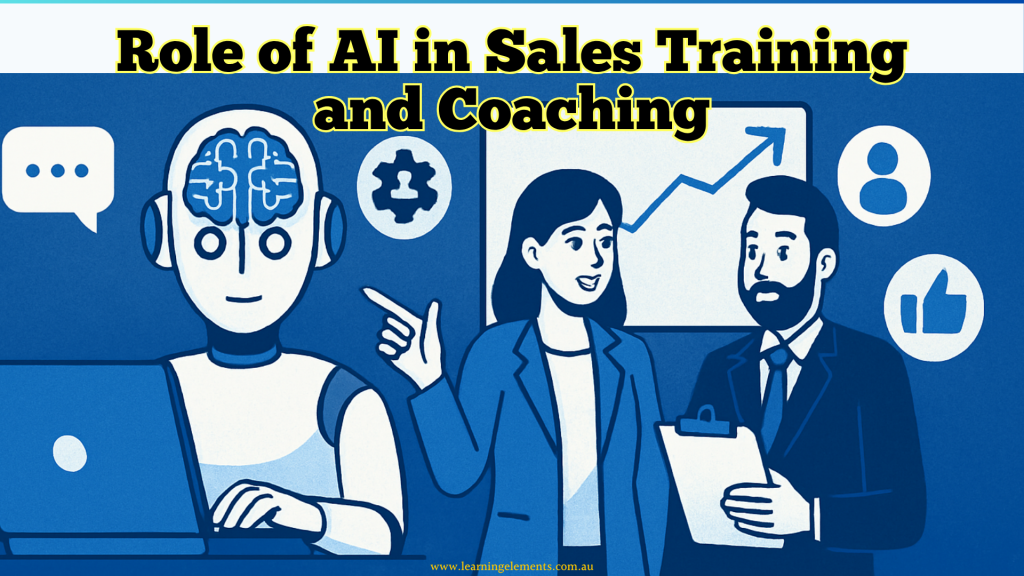
Role of AI in Sales Training and Coaching
AI-Powered Sales Simulations
Reps can practice sales scenarios with AI-generated avatars and environments, preparing them for real conversations. These simulations replicate real-world selling situations—such as cold calls, objection handling, or product demos—using virtual customers powered by AI. The technology evaluates how reps respond, tracks their use of sales techniques, and even scores them on clarity, confidence, and tone.
This form of role-play allows team members to build confidence and sharpen their skills in a low-risk environment. Managers can customise simulations based on specific industries, buyer personas, or deal stages, making training more targeted and effective. Over time, reps become better prepared, faster learners, and more adaptable in real-world selling situations.
Performance Feedback Tools
AI evaluates pitch recordings, tracks speaking time, tone, and language, then provides actionable feedback to improve communication. These tools analyse sales calls, demos, and even emails to assess how effectively a rep communicates. They can detect filler words, track how much time a rep spends talking versus listening, and highlight missed opportunities—such as not asking qualifying questions or failing to address a prospect’s pain point.
Feedback is delivered in real time or as post-call summaries, often with scorecards and suggestions tailored to each rep’s performance. Over time, this helps salespeople develop stronger communication habits, build more trust with prospects, and close deals with greater consistency. It also allows managers to personalise coaching and track individual improvement across the team.
AI and Sales Analytics
Visualising Sales Data with AI
AI dashboards highlight key metrics, trends, and anomalies in visually digestible formats, enabling data-driven decisions. Rather than combing through static spreadsheets or manual reports, sales teams can access real-time, interactive dashboards powered by AI. These platforms automatically pull data from your CRM, email, and call systems to create dynamic visualisations—such as funnel charts, win/loss analysis, activity heatmaps, and forecast projections.
AI can also detect unusual trends—like a sudden drop in engagement or a spike in demo bookings—and alert managers before issues become problems. This makes it easier to track performance, identify bottlenecks, and adjust strategy on the fly, all while keeping teams aligned on key revenue goals.
Behavioural Insights and Trend Tracking
AI identifies which actions led to successful closes—like timing, touchpoints, or communication style—so teams can replicate winning behaviours. By analysing engagement data across thousands of deals, AI can uncover hidden patterns in buyer behaviour and rep performance. For example, it might reveal that deals in a certain industry close faster when followed up within two hours of the initial inquiry, or that reps who ask more open-ended questions tend to win more often.
These insights help sales leaders fine-tune training, outreach strategies, and deal pacing. They also empower reps to learn from what’s working, avoid ineffective habits, and adjust their approach in real time. Over time, this leads to a more refined, results-driven sales process rooted in actual behaviour—not assumptions.
RELATED READ: Sales KPIs That Drive Growth: A Practical Guide for Business Leaders
AI-Powered Market Intelligence
AI tools scrape public data, monitor news and competitors, and even track social sentiment. Reps are alerted to industry changes, funding announcements, or competitor moves—giving them a competitive edge in tailoring their pitch. These insights go beyond simple alerts. AI systems can identify trending topics, emerging market gaps, or strategic shifts in competitor messaging—helping sales teams adapt their outreach in real time. For example, if a competitor launches a new feature, reps can proactively address it in conversations or highlight differentiators. If a target account just raised funding, AI can flag it as a high-priority opportunity and suggest a tailored approach.
This kind of real-time market awareness allows sales professionals to position their offering more strategically, speak to current challenges, and demonstrate a deep understanding of the buyer’s world—all without manual research.
Integrating AI into Your Existing Sales Stack
Compatibility Considerations
Before implementing AI tools, it’s crucial to ensure they integrate smoothly with your existing sales stack—especially your CRM, communication platforms, and analytics systems. Poor integration can lead to data silos, duplicated effort, or system conflicts. Look for tools with open APIs, strong vendor support, and proven compatibility with the software your team already relies on. A seamless setup ensures AI enhances your workflow instead of disrupting it.
Best Practices for Implementation
Start small by piloting one or two AI tools in a focused area like lead scoring or email personalisation. Train your team thoroughly to ensure adoption and clarify how the tool supports their workflow. Monitor key metrics like time saved, conversion rate, or response time to assess effectiveness. As results improve, gradually expand AI across more of the sales process.
Common Mistakes to Avoid When Using AI in Sales
Over-reliance on Automation
AI can enhance efficiency, but relying on it too heavily risks making sales feel impersonal or robotic. Buyers still value human connection, empathy, and real conversation—especially in high-value deals. Use AI to support your process, not replace human judgment. Striking the right balance ensures automation doesn’t compromise the customer experience.
Ignoring Human Touch
AI can streamline outreach, but it can’t replace emotional intelligence, trust, or relationship-building. Buyers respond to authenticity, empathy, and personalised attention—especially in complex sales. Always layer AI-driven insights with human nuance and intuition. Combining automation with genuine connection is what drives real sales success.
Ethical Concerns and Data Privacy in AI Sales Tools
Ensuring GDPR and Compliance
Choose tools that comply with GDPR, CCPA, and local data privacy laws. Respect customer data at every touchpoint.
Transparency in AI Decisions
AI can make powerful recommendations, but sales teams and customers should understand how those decisions are made. Avoid “black box” systems that lack visibility into how leads are scored or actions are triggered. Clear explanations build trust and improve user adoption. Transparency ensures AI works as a trusted advisor, not a mysterious authority.

Future Trends: What’s Next for AI in Sales?
Hyper-personalisation
AI is evolving to deliver messaging tailored not just to company or industry—but to individual preferences, behaviour patterns, and decision styles. Future tools will adapt in real time, creating one-to-one experiences at scale. This level of precision will make outreach more relevant, timely, and effective. It’s where sales is headed: less general, more personal.
Autonomous Selling Agents
Imagine AI bots independently managing small deals or renewals with minimal human input—this is already starting to emerge. These autonomous agents can handle tasks like quoting, negotiating simple terms, and even closing routine transactions without rep involvement. As AI becomes more capable, it’s likely we’ll see end-to-end automation for low-complexity sales. This allows human reps to focus on strategic accounts while AI handles the repetitive, process-driven work behind the scenes.
Summary: 15 Cutting-Edge AI Strategies for Transforming Sales
1. AI‑Powered Lead Generation
Machine learning systems analyse firmographics, browsing behaviour, and engagement signals to spot and prioritise potential buyers automatically. These tools streamline outreach targeting and reduce wasted effort.
2. Predictive Lead Scoring
AI models learn from past conversions to assign scores reflecting a lead’s likelihood to convert. Companies using predictive scoring have realised conversion and productivity gains.
3. Real‑Time Sales Forecasting
Advanced AI dashboards analyse pipeline data and rep activity to generate continuously updated revenue projections, reducing reliance on static forecasts.
4. Personalised Email Campaigns
Generative AI tools craft tailored emails based on recipient data—dramatically increasing open and response rates across segments.
5. AI‑Enhanced CRM Automation
Platforms like Salesforce Einstein and Zoho Zia automate admin tasks like call logging, contact updates, and next-step recommendations—keeping pipelines intact and accurate.
6. Conversational Intelligence
Tools like Gong, Chorus, and Avoma transcribe and analyse calls to extract insights on objection handling, talk ratios, sentiment, and coaching opportunities.
7. AI Chatbots for 24/7 Engagement
Chatbots qualify leads, field basic questions, and book meetings even outside business hours—improving responsiveness and capturing demand.
8. Sales Content Personalisation
AI dynamically tailors proposals, pitch decks, and messaging to match buyer segments, pain points, and buying stages—creating resonance at scale.
9. Behavioural Analytics & Intent Tracking
AI tools monitor indicators such as visits, downloads, and keyword searches to identify buyer intent and trigger follow‑ups at optimal moments.
10. Objection‑Handling Suggestions in Real Time
Some reinforcement learning systems analyse live call context and suggest replies or scripts to overcome objections effectively.
11. Sales Rep Performance Coaching
AI evaluates call sentiment, talk/listen ratios, and linguistic patterns to provide reps with actionable feedback on improving communication and strategy.
12. Smart Proposal Generation & Document Automation
Generative AI tools like Qwilr or PandaDoc automate the creation of customised proposals and quotes—with data pulled from CRM.
13. Dynamic Pricing Models
AI algorithms adjust pricing based on market demand, competitive data, and buyer profiles to maximise revenue and margin. See use in B2C and B2B breakout cases.
14. Workflow & Sales‑Stack Automation
Agentic AI can orchestrate multi-step sales workflows—triggering tasks, reminders, and cross-tool integrations automatically.
15. AI‑Powered Market Intelligence
AI agents scrape competitor moves, news mentions, and social sentiment—delivering context to reps on industry shifts or high-priority deal risks.
Your AI-Powered Sales Strategy Starts Today!
You’ve seen the potential. Now let the Learning Elements team help build your custom AI roadmap.
FAQs
- Can small sales teams benefit from AI? Yes, many AI tools are affordable and scalable for small teams. Even basic automation can save hours weekly.
- Is AI replacing salespeople? No, AI isn’t here to replace salespeople—it’s here to elevate them. It takes over repetitive tasks so sales professionals can focus on what they do best: building relationships, solving problems, and closing deals with a human touch.
- What’s the best AI tool for B2B sales? Tools like Salesforce Einstein, HubSpot AI, and Gong are popular. The best tool depends on your needs and stack.
- Is AI difficult to implement in sales? Many tools are plug-and-play. Training and gradual rollout ensure smoother adoption.
- Are there any risks to using AI in sales? Yes—like over-automation, data breaches, or lack of personalisation. Use AI ethically and strategically.
Conclusion
AI is revolutionising sales—from prospecting and CRM to forecasting and coaching. It boosts productivity, personalises communication, and reveals deep insights that would otherwise go unnoticed. However, it’s essential to balance AI automation with human empathy. Start small, experiment, and build your AI-enhanced sales engine step-by-step.
Ready to outpace your competitors? Start integrating AI today and turn it into your highest-performing sales asset—automated, intelligent, and always working.
Sources:
